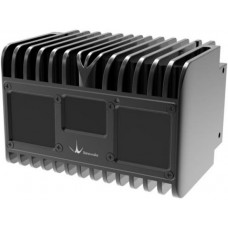Solid-State ToF Infrared LiDAR CE30-D
- Solid-state system (no rotating components)
- Can detect lower obstacles (perfect for AGV or UAV applications)
- Large measuring range: max to 30 meters with centimeter-level accuracy
- High resolution: angular resolution reach to 0.19 degree (3 mrad)
- FOV 60*4 degrees / Accuracy: ≤15cm
This Solid-State ToF Infrared LiDAR CE30-D is equipped with its special hardware design. It can complete the measurement of wide horizontal FOV and output the grey and depth information at the same time. Compared with single-line scanning LiDAR that only detect in a horizontal plane, CE30-D can detect lower obstacles. Also, it does not contain any rotating compartments, which could ensure the reliability of the long-time work and a wider vertical detecting range.

The ranging principle of CE30 is based on Time of Flight (TOF). The modulated near-infrared light is emitted from CE30, which will be reflected by an object and received by CE30 again. CE30 calculates the phase difference and time difference between the emitted and received light to determine the distance between the CE30 and a detected object.

Its horizontal field of view is 60 degrees and vertical field of view is 4 degrees. Compared with single-line LiDAR, CE30 has a wider vertical FoV and therefore the object can be better recognized. In a measuring period, each frame will detect a different distance range. The LiDAR combines all these frames to get all distance data within measuring range.

CE30-D has 20 lines in vertical direction, and the vertical angle resolution is 0.2 degree, so that CE30-D has more precise resolution capacity. The communication protocol stipulates that the length of all commands is fixed to 50 bytes. If the actual length of the command string is shorter than 50 bytes, the last should be filled with 0x00 after the end of command string to reach the length of 50 bytes. After the LiDAR is powered up, a command is needed to start measurement.
Specifications
- Method: Time of flight
- Peak Wave Length: 850nm
- FoV: 60*4 degrees
- Pixel Resolution: 320*20
- Angular Resolution (vertical): 0.2 degree
- Frame Rate: 30fps
- Ranging Resolution: 1cm
- Detecting Range: 0.4~30m@90% reflectivity
- Repeatability (1σ): ≤5cm
- Accuracy: ≤15cm
- Ambient Light Resistance: 60klux
- Data Interface: UDP
- Operating Temperature: 0-50
- Supply Voltage: DC 12V ± 0.5V(≥3A)
- Power Consumption: ≤8W
- Enclosure Rating: IP65
Enter the code in the box below:

